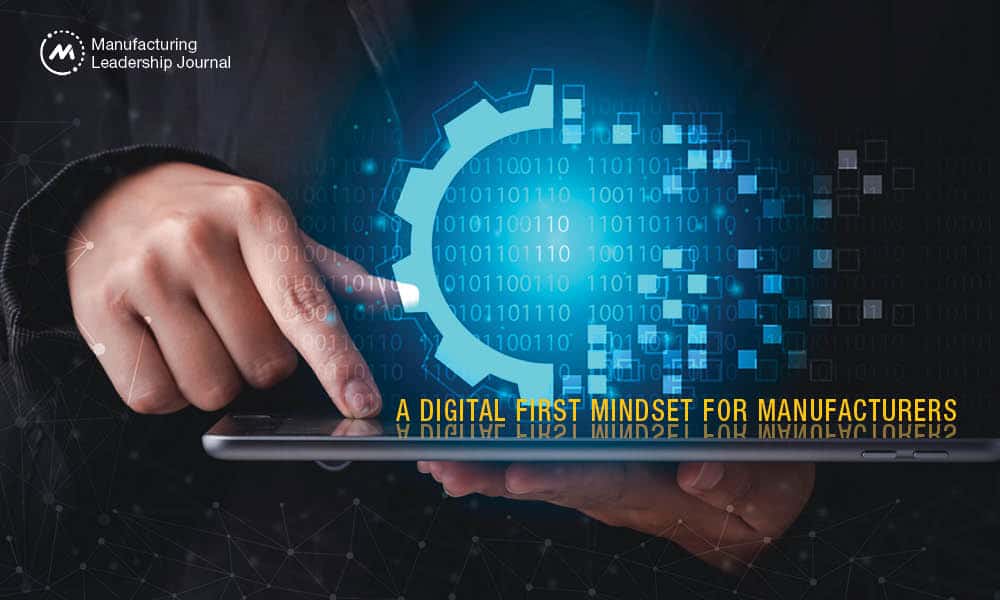A Digital First Mindset for Manufacturers

Follow these five steps to enable planning, collaboration and investments in talent and technology that are vital to digital transformation.

TAKEAWAYS:
● Manufacturing companies must invest now in digital infrastructure to collect and analyze data for insights, optimization and quality improvement.
● Embracing automation will enhance efficiency and free up employees for more complex tasks.
● Collaborate with partners and invest in talent development while prioritizing cybersecurity to protect your organization’s digital assets.
The Challenge
Digital operations and data analysis are transforming the future of manufacturing. We are already seeing examples of the power of digital and data to inform, automate, and improve manufacturing processes from strategic planning to execution. Companies incorporating digital capabilities have proven efficiency gains (think constraint management, overall equipment effectiveness (OEE), quality, predictive maintenance, compliance), but will also see strategic advantage in becoming more formidable in on-going battles related to the dwindling manufacturing labor pool, demand and supply volatilities, and the overarching pervasive need to find levers to support growth or maintain already tight margins. But for most manufacturing companies, delving into digital is easier said than done with common hurdles including technical debt, reluctance to change and ineffective data management.
Operating in a digital age starts with letting go of legacy systems, processes and ways of working. But even the biggest manufacturing companies are burdened by technical debt, with outmoded systems that are incompatible with modern digital technologies. This can make it difficult to integrate new solutions into existing data, workflows and processes.
Beyond technical debt, employees can be wary of adopting new digital technologies due to a lack of understanding or fear of job loss. This can slow the adoption of digital solutions and hinder organizations’ ability to innovate.
Another complication is data management. Manufacturing companies generate vast amounts of data from machines, products and customers. However, this data is often siloed and not easily accessible or usable. This can make it difficult to gain insights into customer needs and preferences, optimize production processes, and improve product quality.
So, how do manufacturers prepare for the digital future?
Five Steps for Digital Success in Manufacturing
To shed legacy systems, bring employees on board and do more with data, it is important to invest in digital infrastructure supporting digital information systems. This will enable the collection and analysis of data from machines, products and customers to gain insight into customer needs and preferences, optimize production processes and improve product quality.
Alongside this, embracing automation will reduce costs, improve efficiency and increase productivity. By automating repetitive tasks, manufacturers can free up their employees to focus on more complex tasks that require human skills. But doing this requires careful planning, collaboration and targeted investment in talent and technology.
1. Assess the current state of digital readiness
To achieve digital success, it is vital for manufacturing companies to assess their current state of digital readiness. This all-important gap assessment helps organizations’ leadership teams to identify areas and opportunities for improvement. With this knowledge in mind, leaders can begin to prioritize their efforts and allocate resources more effectively. When selecting the most critical areas for improvement, success will be more likely when these improvement areas align with business goals and customer needs. This will help them focus their efforts on initiatives that have the greatest impact.

“Even the biggest manufacturing companies are burdened by technical debt, with outmoded systems that are incompatible with modern digital technologies”
2. Develop a roadmap for digital transformation
Having assessed their organization’s current state of digital readiness, manufacturing leaders can develop a roadmap for digital transformation that sets goals, priorities and timelines for deploying digital initiatives. This roadmap, with timebound tasks and responsible owners, focuses on objectives and avoids wasting resources on initiatives that do not align with business goals.
It is often the case that organizations throw themselves into adopting new technology and systems without necessarily considering how it supports the overall business strategy. A shiny new digital system powered by artificial intelligence might seem like a worthwhile investment but is unlikely to deliver a return on investment if it does not address a key operational need or challenge.
3. Collaborate with partners across the value chain
Customers, suppliers and service providers should be collaborators – looking at what other organizations are doing to become more digital can provide useful insight and experience. Manufacturing companies can collaborate with partners across the value chain to share data, expertise, and best practices to help them identify new opportunities for growth and innovation. They can also look beyond their own industry for inspiration and knowledge.
4. Invest in talent development
One of the key reasons firms can struggle to adopt digital is because their teams are not ready to do so. Much of this comes down to attitude, and feeling safe experimenting with new systems without worrying that they will be replaced. Helping employees to feel confident about digital systems and emergent technologies is part of the battle. A company that has had great success with digital adoption on the shop floor has worked to shift roles from operators to optimizers. It is essential to ensure employees have the right skills and knowledge to succeed in a digital environment. This starts with leaders who demonstrate the behaviors and skills required, and with digital champions who help their colleagues to build familiarity. Providing training programs, hiring new talent with digital skills, and partnering with educational institutions to develop new curricula can help to drive towards a digitally savvy workforce.

“By automating repetitive tasks, manufacturers can free up their employees to focus on more complex tasks that require human skills”
5. Prioritize cyber security
More digital assets mean a greater threat of compromise (malicious or unintentional) of IT/OT systems leading to potential to manufacturing disruptions, faulty planning and management decisions, quality issues, compliance violations or damaged business partner relationships. Conducting regular cyber security audits can flag any potential risks before they become issues and inform proactive measures to limit the negative impact. Manufacturing companies can also partner with cyber security experts to develop a comprehensive strategy.
Manufacturing organizations face myriad strategic and operational challenges; however, charting a path to digital is critical to remaining competitive and thriving in the future. Technical debt and resistance to change must be tackled head on to achieve a successful digital future. Additionally, recognizing and addressing the expanded exposure to IT/cyber risk via digital and accelerated dynamics of talent development is critical to a sustainable digital future. M
About the Authors:

Michael Platz is a Supply Chain and Manufacturing Operations Expert at PA Consulting

Shanton Wilcox is a Partner and America’s Leader in Manufacturing at PA Consulting